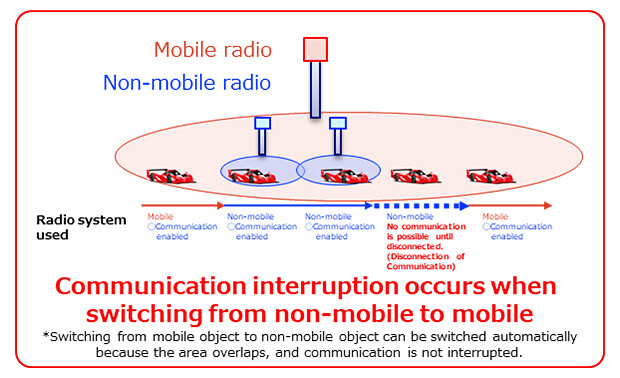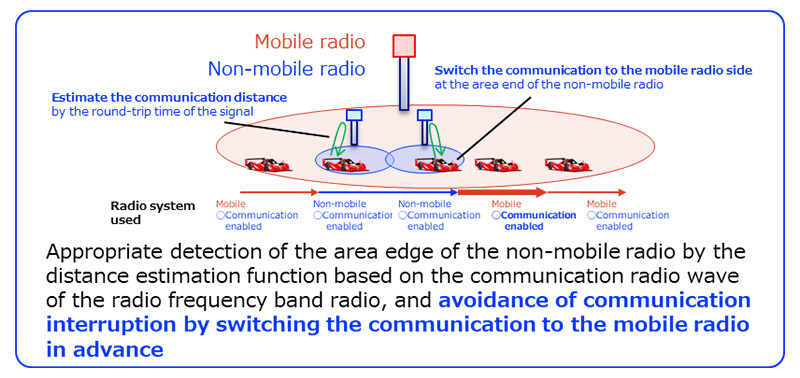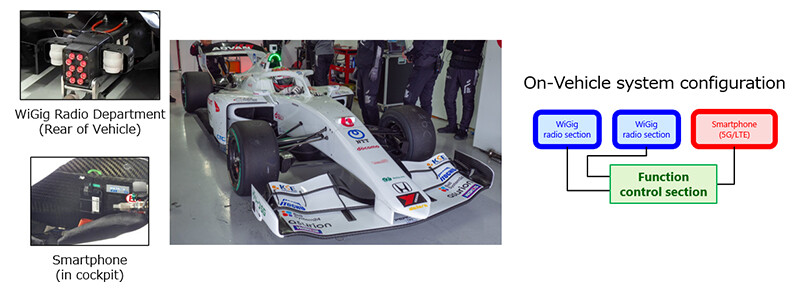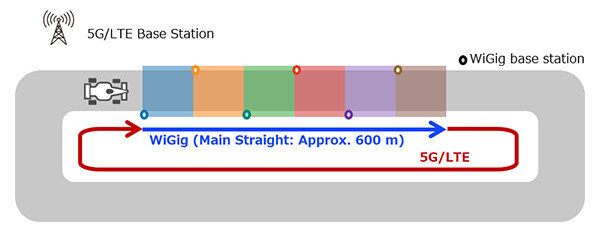Microsoft ends support for Internet Explorer on June 16, 2022.
We recommend using one of the browsers listed below.
- Microsoft Edge(Latest version)
- Mozilla Firefox(Latest version)
- Google Chrome(Latest version)
- Apple Safari(Latest version)
Please contact your browser provider for download and installation instructions.
April 26, 2024
NTT Corporation
World's first seamless switching experiment between 60 GHz band wireless LAN and 5G/LTE based on distance measurement using radio waves
Demonstrated avoidance of communication interruption in an ultra-high-speed mobile environment through demonstration experiments using formula cars
News Highlights:
- In response to the problem that the characteristics of a non-mobile wireless communication system such as a wireless LAN deteriorate and communication is interrupted at the area end when it is applied to a mobile terminal, we devised a seamless switching technology that avoids communication interruption by detecting the area end of the non-mobile wireless communication system and switching the communication to the mobile wireless communication system in advance by distance estimation using communication radio waves, which are the characteristics of high-frequency band radios.
- Demonstration test using a formula car demonstrates that communication interruption can be avoided in an ultra-high-speed mobile environment
- It will be possible to use a non-mobile wireless communication system even in a mobile environment without fear of communication interruption, and is expected to further increase the capacity of wireless communication in mobile terminals
Tokyo - April 26, 2024 - NTT Corporation (NTT) has devised a technology to seamlessly switch between 60 GHz band wireless LAN (WiGig1), a non-mobile wireless communication system, and 5G/LTE, a mobile wireless communication system, by distance estimation using radio waves, and has successfully demonstrated this technology in an ultra-high-speed mobile environment using a formula car.
This technology combines a high-frequency band non-mobile wireless communication system, which was previously available only for mobile terminals with a limited range of movement, such as indoors, with a mobile wireless communication system seamlessly, enabling the technology to be used even for mobile terminals that move over a wide area, such as high-speed mobile trains and drones. This technology enables mobile terminals to use high-frequency band non-mobile wireless communication systems as off-road destinations for mobile wireless systems, and is expected to increase the capacity of wireless communications.
This technology will be introduced at the Tsukuba Forum 20242 to be held from, May 16 to 17, 2024.
1. Background
In the IOWN3/6G era, in addition to higher frequency bands such as the millimeter wave band and the sub-terahertz band, it is expected that non-mobile wireless communication systems, such as wireless LANs, that can achieve high-capacity communication will be used to increase the capacity of wireless communications.
WiGig is one of the non-mobile wireless communication systems using high-frequency bands that can meet these expectations. WiGig is a 60 GHz version of a wireless LAN and is a non-mobile wireless communication system capable of wireless transmission of up to 4.62Gbit/s4 in a single frequency channel. However, the zone where a single base station can provide service is narrower than that of a mobile wireless communication system, and it is difficult to use a non-mobile wireless communication system for mobile terminals that move at high speed over a wide range of areas, such as drones, cars, and high-speed trains, due to the problem that it is not possible to switch the connection destination base station or communication method until communication is completely interrupted.
In response to this problem, NTT developed the Base Station Switching Control Technology5, which instructs and controls the appropriate base station switching timing and switching destination based on the positioning of the terminal using WiGig communication radio waves, and the Terminal-Driven Dynamic Site Diversity Control Technology6, which avoids the interruption of communication during base station switching by controlling the coordination of multiple radio units, with the aim of adapting the non-mobile wireless communication system itself to the mobile terminal, that is, switching the base station of the non-mobile wireless communication system without interruption, and demonstrated its effectiveness in an ultra-high-speed mobile environment using a formula car.
However, the above problem also manifests itself when the mobile terminal leaves the area of the non-mobile wireless communication system. In other words, due to the nature of the non-mobile wireless communication system that attempts to maintain a connection with the currently connected base station, the switch to the mobile wireless communication system is not performed until the connection is disconnected and communication is completely interrupted, resulting in a problem in which communication with the network is temporarily disconnected (communication interruption: Figure 1). Thus, to increase the capacity of wireless communications by utilizing a non-mobile wireless communication system in a mobile terminal, it was necessary to have a control technology that not only made the non-mobile wireless communication system itself compatible with the mobile, but also realized seamless linkage with the mobile wireless communication system.
 Figure 1 Challenges in Merging Mobile and Non-mobile Radios
Figure 1 Challenges in Merging Mobile and Non-mobile Radios
2. Results of the research
To solve the above problem, NTT has focused on the fact that WiGig communication radio waves themselves are capable of highly accurate communication distance estimation based on the wideband nature of high-frequency band radios. NTT has devised a technique (Seamless switching technology) to seamlessly switch communication to a mobile wireless communication system by avoiding communication interruption by detecting that the terminal reaches the area edge of the non-mobile wireless communication system based on the estimated distance and switching to mobile wireless communication before the connection with the non-mobile wireless communication system is disconnected.
In this method, by acquiring information on the round-trip transfer time of the beam control information required for wireless communication in the high-frequency band, the communication distance with the base station of the non-mobile wireless communication system is estimated at the terminal side without relying on other positioning systems such as GPS. When the communication distance approaches the expected communication limit of the non-mobile wireless communication system, the terminal switches communication to the mobile wireless communication system side even when the connection with the non-mobile wireless communication system is maintained.
This makes it possible to seamlessly switch communication to the mobile communication system side and maintain communication without being affected by the deterioration of transmission characteristics at the area edge of the non-mobile wireless communication system. This makes it possible to further increase the capacity of wireless communication by utilizing the non-mobile wireless communication system in mobile terminals.
 Figure 2 Proposed Seamless Switching Technology
Figure 2 Proposed Seamless Switching Technology
3. Overview of the experiment
A demonstration test of this technology was conducted at the 2024 All Japan Super Formula Championship Official Joint Test (February 21 to 22, 2024) under the technical cooperation of the racing team "DOCOMO TEAM DANDELION RACING" for the provision and operation of a formula car that reproduces an ultra-high-speed travel environment, and NTT DOCOMO, INC. and DOCOMO Technology, Inc. for the construction of an area for the ultra-high-speed travel test and the installation of a terminal on a vehicle.
As shown in Figure 3, two WiGig radio units are installed in the rear of the vehicle, a 5G/LTE smartphone is installed in the cockpit, and a function control unit for controlling these functions is installed in the side pontoon on the left side of the vehicle. The radio function section generates dummy data for throughput measurement at a rate of 5 [Mbit/s] and switches the communication system based on the control of the proposed seamless switching technology.
On the ground side, six WiGig base stations were installed on the left and right sides of the main straight of the Suzuka Circuit. WiGig was used for communication on the main straight, and 5G/LTE was used for other locations in the course (Figure 4). The base station switching control technology described above is applied to the six WiGig base stations, and the terminal-driven dynamic site diversity control technology using two WiGig radio units is applied to the terminals, so that no communication interruption occurs in the WiGig zone. In addition, dummy data sent from the vehicle side was configured to reach the throughput measurement server installed on the ground side via the WiGig base station in the WiGig zone and via the 5G/LTE base station in other locations, and the throughput measured by the server was evaluated.
Figure 5 shows the throughput without seamless switching technology and Figure 6 shows the throughput with seamless switching technology. In Figure 5, you can see that there are several tens of meters (hundreds of milliseconds in time) where the throughput is 0 [bit/s] when switching from WiGig to 5G/LTE. Due to the nature of non-mobile wireless communication systems, it is not possible to switch communications to 5G/LTE until after WiGig is completely disconnected. On the other hand, in Figure 6, it can be seen that there is no communication interruption in switching from WiGig to 5G/LTE by applying the proposed seamless switching technology. In other words, by applying the seamless switching technology, we confirmed that we could avoid communication interruption by switching the communication to the mobile communication system side in advance using the ranging function based on communication radio waves at the area edge of the non-mobile wireless communication system.
At the time of this technology demonstration, the vehicle speed was up to 278 km/h at around 550 m, and 254 km/h or more at the point of switching from WiGig to 5G/LTE (measured by GPS installed for the experiment), demonstrating the effectiveness of the proposed seamless switching technology in an ultra-high-speed mobile environment.
 Figure 3 Formula Car and In-vehicle System Configuration Used in the Experiment
Figure 3 Formula Car and In-vehicle System Configuration Used in the Experiment
 Figure 4 Experimental Structure
Figure 4 Experimental Structure
 Figure 5 Throughput Characteristics Without Application of the Proposed Technology
Figure 5 Throughput Characteristics Without Application of the Proposed Technology
 Figure 6 Throughput Characteristics When the Proposed Technology is Applied
Figure 6 Throughput Characteristics When the Proposed Technology is Applied
4. Outlook
Through this experiment, we applied WiGig, one of the high-frequency band non-mobile wireless communication systems, to a high-speed mobile terminal. We confirmed that we could stably achieve large-capacity transmission by avoiding degradation of characteristics by switching the communication to the mobile wireless communication system before the connection is disconnected by detecting the approach to the area edge of the non-mobile wireless communication system by using the ranging function of communication radio waves.
This result is expected to be used not only in WiGig but also in various high-frequency band wireless transmission systems, and as a technology to select other wireless systems appropriately without relying on external positioning systems such as GPS in a mobile environment where terminals move, even if the mobile environment is not a very high-speed mobile environment such as this experiment. Specifically, in the following use cases, it is possible to utilize non-mobile wireless communication systems such as high-frequency band wireless LANs in addition to the conventional mobile wireless communications such as 5G.
- High-capacity transmission of video data to fast-moving trains and cars
- High-capacity transmission of sensing data in vehicles, specifically video data of vehicle drive recorders, peripheral scan data by LiDAR7, etc. to the ground side at gates
- High-capacity transmission of mobile video data such as moving drones and robots to terrestrial networks
In the future, we will use the results of this demonstration experiment to study the technology to apply this technology in various usage environments and realize more stable and large-capacity wireless transmission. Although this experiment targets non-mobile wireless communication systems, the underlying technology is a range-finding function that focuses on the nature of high-frequency bands. This technology is expected to be used not only for non-mobile wireless communication but also for wireless communication systems in all high-frequency bands. Through this technology, we will continue to study its application to high-frequency band wireless communication systems that are being considered in the IOWN/6G era.
1WiGig
Short for Wireless Gigabit. Wireless LAN standard using 60 GHz band based on IEEE 802.11ad standard
2Tsukuba Forum 2024
https://www.tsukuba-forum.jp/e/
3Innovative Optical and Wireless Network (IOWN) The IOWN is comprised of three components: the "All Photonics Network (APN)," which makes it possible not only for networks but also for terminal processing; the "Digital Twin Computing," which enables advanced and real-time interaction between objects and humans in cyberspace; and the "Cognitive Foundation," which efficiently deploys various ICT resources
4Single Carrier Basic Mode Maximum Transmission Rate IEEE Std-802.11TM-2016 (Revision of IEEE Std 802.11-2012)
5https://group.ntt/en/newsrelease/2021/02/03/210203a.html
6https://group.ntt/en/newsrelease/2022/02/25/220225a.html
7LiDAR (Light Detection and Ranging)
Sensing method for grasping the surrounding environment by observing reflection from objects existing in the surroundings by irradiating light such as laser
About NTT
NTT contributes to a sustainable society through the power of innovation. We are a leading global technology company providing services to consumers and businesses as a mobile operator, infrastructure, networks, applications, and consulting provider. Our offerings include digital business consulting, managed application services, workplace and cloud solutions, data center and edge computing, all supported by our deep global industry expertise. We are over $97B in revenue and 330,000 employees, with $3.6B in annual R&D investments. Our operations span across 80+ countries and regions, allowing us to serve clients in over 190 of them. We serve over 75% of Fortune Global 100 companies, thousands of other enterprise and government clients and millions of consumers.
Media contact
NTT Information Network Laboratory Group
Public Relations
nttrd-pr@ml.ntt.com
Information is current as of the date of issue of the individual press release.
Please be advised that information may be outdated after that point.
NTT STORY
WEB media that thinks about the future with NTT










